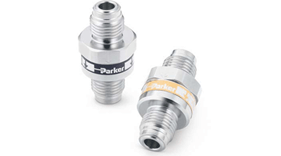

At Fluid Controls, we understand how important high purity valves are to many applications and processes. To guide you through the selection process, we have created this check valve vs diaphragm valve blog to give you some insight into which high purity valve would be best for your application. Read on to discover how each valve works and the different types available at Fluid Controls.
A check valve, non-return valve or one-way valve is a valve that normally allows media (liquid or gas) to flow through it in only one direction, thereby preventing any backward flow. Check valves are two-port valves, which means they have two openings in the body: one for fluid to enter and the other for fluid to exit. Fluid Controls’ high purity check valves are generally small and inexpensive, which is a major part of their appeal.
Diaphragm valves, also known as membrane valves, are similar to check valves in terms of what they achieve. However, they work in a different way. High purity diaphragm valves are made up of a valve body with two ports, a diaphragm and a seat. The diaphragm rests upon the seat in order to close the valve. Diaphragm valves are generally used as shut-off valves in the industrial, food and beverage, and pharmaceutical industries.
At Fluid Controls, we supply many different types of check valve from well-renowned manufacturers, Parker. These valves are designed for the uni-directional flow control of fluids and gases in industries such as chemical processing, oil and gas production and transmission. Within this range is the F9 high purity check valve, hi check valve and the C and CO series check valves.
Parker Veriflo’s F9 high purity check valve is an all-welded valve, featuring a patented asymmetric spring design for a consistently quiet operation. The F9 series check valve offers high CV in a small footprint to conserve much-needed panel space.
Two seal materials achieve compatibility with all semiconductor gases, reducing inventory requirements. These high purity valves are Class 100 clean room assembled and packaged, while VeriClean™ 316L stainless steel is designed for electropolishing and corrosion resistance.

As diaphragm valve distributors, we can cater to whatever type of diaphragm valve you are looking for. At Fluid Controls, we only work with the finest valve manufacturers, so we can ensure your valve will be of the highest quality. We supply high purity diaphragm valves from leading manufactures, Parker, including thire Quantum, Titan and Surface Mount series of valves.
The Parker Veriflo Quantum 930 diaphragm valve is designed specifically for ultra-high purity applications, with minimum particle generation and entrapment areas. This diaphragm valve is fully functional from vacuum to 8.6 bar (for air operated) and 17.2 bar (for manual versions). The 930 valve features an internally threadless and springless design with field replaceable seat.

For more information on check valve types or high purity diaphragm valves contact us today on +44 (0) 118 970 2060 or via email at fluid@fluidcontrols.co.uk. You can also visit our website for more information on our range of products.